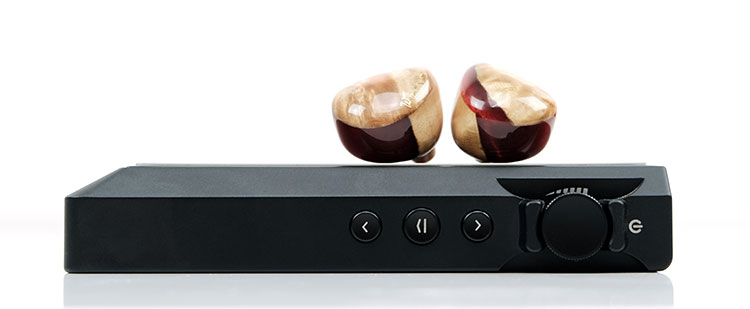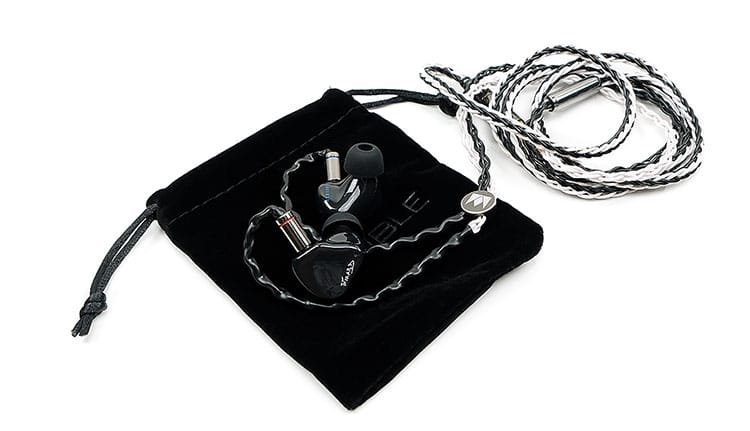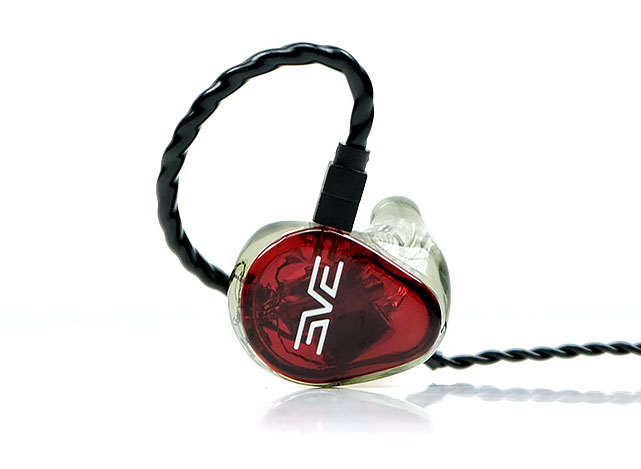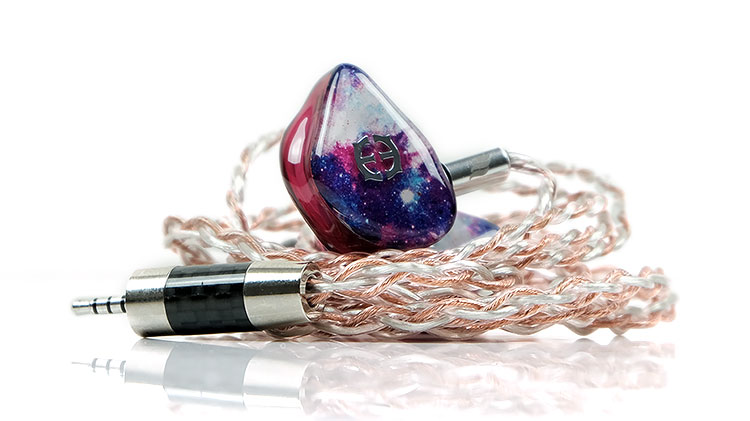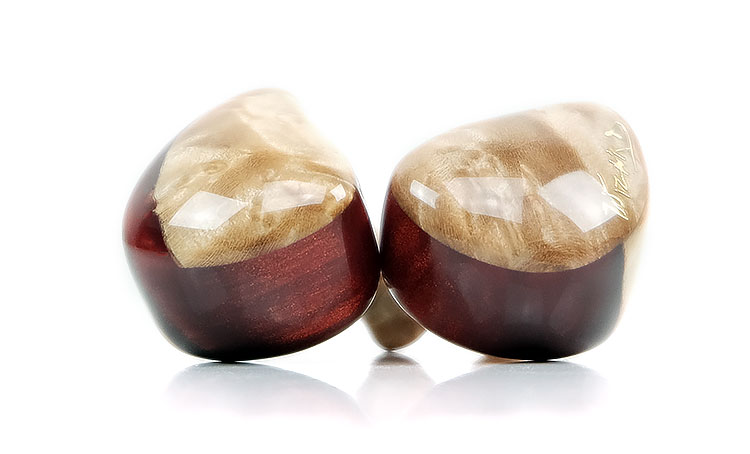Zephyr Sound Impressions
Summary
The Zephyr does not sound like your regular triple driver, not by a country mile. I suspect the secret in the sauce is that the new dynamic driver adds some welcome solidity and depth to the lows compared to an all-BA design but there is more to it than that.
The tuning is a little north of neutral in terms of ‘musicality’ introducing a nuanced blend of mid-bass warmth, a rising midrange that bumps from 700Hz to around 1-2k, and then a forward upper-midrange from 3-4/5k.
The treble is not rolled off, as in limited by driver range or flaws but rather it is gently faded from 5-7k and then a minor bump at 8k for headroom.
I think that the last statement is really important with the Zephyr because it sounds energetic but not peaky or splashy at the same time. Noble has done a great job getting the balance just right in terms of note thickness and where to emphasize Zephyr’s response curve to deliver what I consider to be a very versatile and engaging sound.
If there is a bias in the overall Zypher tuning I would argue it is to the mids with two peaks at 1-2k and a more substantial rise at 3-4k. These do push the positioning of vocals out and forward creating a more stretched but center-focused presentation where vocals can really shine.
Dynamic Driver
The new dynamic driver is tuned with more of a linear sub-bass response to a mid-bass peak and is quite different from something like the Empire Ears Valkyrie, another 3-driver with a slightly smaller 9mm dynamic driver tuned for the lows.
It is not as overly dominant or as powerful as the Valkyrie but it does sound solid with excellent depth and punch as you would expect from a good dynamic driver. Compared to EVE20’s dual BA for the low-ends, it does not have quite the same elevation but the density is better right at the low end with a slightly more natural level of decay.
The lack of dominant sub-bass bloat and a minor drop post 300Hz does create some welcome space for instrumental presence just shy of 1k to sound meaty rather than lean. A tuning that does bode well for those who enjoy their rhythm guitar chugging and chord crunching.
Timbre
I have to confess I love the timbre on the Zephyr. It has a beautifully natural if slightly dense tone to instrumental notes and vocal performances. It is not a lush and romantic tone or as warmed and rich as the Savant II but neither is it overly ethereal or brittle sounding either.
There is a slight bias to even-harmonics from that mid-bass warmth that carries into the mids and I can sense Noble has been careful not to push the final BA too hard in an effort to bring in a high level of contrast and sparkle for higher-pitching instrumental timbre.
That means you get energy but without any unwelcome sharp partial overtones which some might have expected with that elevated upper-midrange curve. Percussion has excellent presence and body but without any grating shimmer or emphasized sibilance pressing down into the vocal timbre.
Staging
The Zephyr has some really good depth and a very nice level of bass extension but it is not sub-bass dominant and not as powerful sounding as some other large dynamic driver IEMs out there. I would class it a neutral sub-bass performance rather than rolled-off with more of a meaty mid-bass punch to deliver that PRaT.
Lower-mid instruments are not terribly dipped or diffuse within the Zephyr’s staging which I like. It offers some very nice solidity and presence to rhythm and bass guitar and doesn’t crowd out vocals which have that 1-2k bump for males and an upper mids rise for females.
Both vocal pitches come across as forward and clear on the Zephyr and quite a contrast to the more recessed U-shaped performance of the Tux 5 and its respective vocal positioning.
One thing to note though is that the Zephyr staging can sound a bit center-focused depending on your source and generally not as expansive in the mids as something like the EVE20. You do not get quite the same left-right separation or staging width with more of an intimate ‘vocal first’ delivery.
Height is good but not hugely extended with more of a lower-treble and upper-mids focus. Certainly not as extended as the Sultan or as forward as the Khan but given their use of electrostatic and piezoelectric drivers that is not surprising. I certainly do not find the Zephyr congested or veiled with that mid-centric performance but it is a ‘closer’ sound.
Synergy
Efficiency
Noble rarely tells us much in terms of impedance and SPL for their monitors. Most of the time we generally just start listening to them compared with IEMs we do know the ratings and volume match.
It is not an exact science but it does give us a ballpark understanding of current demand at least for the Zephyr.
Our test platform was the iBasso DX220 MAX which has a very low noise floor and a dual current level control via the DAC and analog amp.
We set the DAC level control to 130 out of 150 and the gain setting to low (unbalanced) to get the following results. (Note the analog pot is independent and thus we refer to the marker position in a 12-hr time format).
From our side-by-side testing, the Zephyr closely matches the tia Trio in terms of SPL so I would probably class the Zephyr as a medium efficiency monitor and not terribly inconsistent from the Noble legacy of never putting out hugely sensitive IEMs.
An SPL rating of around 104-106dB SPL would not be that far off and most likely the common denominator is the dynamic driver.
As for impedance, it is anyone’s guess but it will not skew with high impedance outputs from the likes of the HiBy R6 so high enough to work well with most modern sources. You just need a decent amount of current and on the flipside, background hiss is not an issue with DAPs such as the FiiO M15 and the tube-infused Cayin N3Pro.
Don’t be shy about trying it with a good smartphone, however. It is not voltage-hungry enough to collapse like a deck of cards and phones such as my Samsung Note 9 went high for volume but not to the full limits before it got too loud.
Pairings
I tended to prefer pairings that optimized the channel separation and dynamic range of the Zephyr.
The timbre already has a nice balance to it so it is not that critical you get a source whose own sound is a perfect match for it. It plays out just as well with tubes and solid-state sources and is receptive to some minor tweaking via EQ or PMEQ.
The more important pairing approach is on the technical side. All of our tested DAPs were blissfully noise-free with the Zephyr so that is a bonus. However, the level of separation, particularly in terms of staging width did become more important.
For example, the Cayin N3Pro tended to produce a very center-focused sound with less separation and dynamic range compared to the E02 motherboard with the Cayin N6ii. The additional channel separation of the E02 made a worthy difference to the staging of the Zephyr pushing it out wider with better instrumental separation.
I felt the same way with the iBasso DX220 MAX though the overall sound was perhaps a shade more neutral in its delivery compared to the E02 so for those wanting a bit more sub-bass weight you might have to dig into the Mango PMEQ for 2-3dB of 20-250Hz (q factor 0,3) of additional power and warmth.
I would avoid excessively dry or bright sources such as the Astell & Kern AK240. Its lack of low-end heft robs the Zephyr of some needed richness in the timbre and a bit of PRaT also.
If you are going to go neutral try the Lotoo PAW Gold Touch which has a much better level of dynamic range and power. The Zephyr actually sounded really punchy with the Lotoo.
Select Comparisons
Noble Audio TUX 5
$1300
Technical
The Tux 5 is priced a little lower than the Zephyr at $1300 which might surprise some since it is a 5-driver hybrid as opposed to 3 drivers. I suspect the driver choices here will be different from the Zephyr hence the different positioning.
The Tux 5 uses a single 10mm dynamic driver which seems to be Noble’s favorite driver size these days. That 10mm is complimented by four balanced armature drivers. The overall configuration for the BA drivers is two for the mid-low frequencies, and two for the mid-high frequencies. That leaves the 10mm dynamic driver free to focus on the lows.
The Tux 5 grouping would indicate dual-driver Knowles and a 4-way crossover configuration. This compares to Zephyr’s new 10mm dynamic driver for the lows, a single BA each for the mids and highs using a 3-way system.
We do not know the specs for either but despite packing a few additional drivers inside, the Tux 5 was marginally less demanding compared to the Zephyr, at least for current.
We tested both on the iBasso DX220 MAX with the preamp setting at 120 and the Tux 5 was the louder of the two at a higher current, (1-2 pm on the analog pot as opposed to 2-3 pm for the Zephyr).
Background hiss is not an issue for these two sources such as the Cayin N3Pro or the FiiO M15. Both are a little too sensitive for Hifiman’s R2R2000 lineup with only 0-5 steps possible on low gain unbalanced.
Design
Unlike the Zephyr the Tux 5 only comes in black with a white Wizard and logo motif, hence the name Tux for Tuxedo. The Zephyr can be bought in universal, custom, and prestige format so prices vary and can go much higher (Prestige).
I actually found the Tux 5 to be at odds with the general ethos of Noble designs save for the longish nozzle. It has a tried and tested all acrylic body and more aggressive contouring than the Zephyr. That means it is smaller and lighter compared to the Prestige but not as fancy in looks compared to the sumptuous wood resin finish of the Zephyr.
Both come with the same selection of tips so the in-ear isolation levels are similar. The bigger difference is the size factor with the Zephyr sitting out of your ear more than the Tux 5.
Still, I thought the heavier Zephyr would make its presence felt more but it really wasn’t the case at all. Both felt similar in the ear and also better with the Final E 3rd party tips attached.
One other cosmetic difference is the stock cable. Both use Noble’s new 1.2m 8-core OCC wire in an all-black finish and multiple termination options, however, the Tux 5 jacket is a two-tone black and white to fit in with the tuxedo theme whereas the Zephyr is all-black.
Tuning
The Tux 5 is more of a U-shaped bass cannon with a high dose of treble contrast to balance it out. Mids come 3rd. Though not overly recessed they lack a bit of body and presence which is where the Zephyr has more forwardness and focus.
The Zephyr from 2-4k has more of a bump than the Tux 5 but also less of a treble dominance around 5-7k. Female vocals have a smoother richer tone to them on the Zephyr, as do percussion timbre. The Tux 5 is a little leaner with more treble shimmer on the overtone down to about 2k so higher-pitching notes have this slightly more ethereal quality to them.
On the low end, the Tux 5 is tuned for a deeper and more powerful response with an L-like dip from the sub-bass down to that 1k marker. The Zephyr does not have the same sub-bass weight, instead, it sounds punchier with more of a mild mid-bass rise and a sub-bass response that is more or less linear to the mid-bass.
The Zephyr low-end is still very much a dynamic driver timbre but has less quantity/power, sounds a bit faster, and tighter than the Tux 5 low-end tuning.
Overall, the Zephyr delivers a better mids focus, a balanced natural sounding timbre with a more intimate soundstage. The Tux 5 focuses instead on more low-end power and treble headroom but with a more diffuse midrange and a high contrast timbral quality to vocals and instruments.
Give me the Zephyr for classic standards and modern rock and switch to the Tux 5 for modern EDM.
Vision Ears EVE20
€1300
Technical
The EVE20 is roughly the same price as the universal format of the Zephyr, however, you could call it Vision Ear’s prestige design because they are using a lot of their custom know-how to develop the universal EVE20 format. It is also a limited edition launch and is only available for 2020.
The internals are very different. The EVE20 is an all-BA driver affair compared to the Zephyr with 6 drivers including a dual-vented sub, a dual full-range driver, and a dual mid/high BA driver.
The precise grouping of the drivers is 2 for the lows, 2 for the mids, and 2 for the highs compared to Zephyr’s 10mm dynamic driver for the lows, and BA’s for the mids and highs. The EVE20 weaves the drivers together with a 3-way acoustic/electric crossover and the Zephyr also uses a 3-way system.
The EVE20 is rated at 25Ω and 120.5DB SPL and though we do not know the precise rating of the Zephyr we do know the EVE20 is easier to drive from our side-by-side tests in our synergy section.
Both are not that hard to drive to be honest but the EVE20 will be the more sensitive of the two to higher noise floors and the Zephyr will deliver a blacker background with its middling efficiency.
Design
Both are beautifully designed but with some important differences. The EVE20 is an all-acrylic finish with a heartwood faceplate whereas the Zephyr Prestige uses a more exotic maple burl and resin mix for a very unique all-wood look.
The EVE20 is smaller, much smaller, and also lighter compared to the Zephyr. The Zephyr works its magic via that long nozzle that penetrates deeply but its bigger form factor does stick out a bit more.
Tips play a role with both monitors. Personally, for both, I am picking the Final E because the SpinFits that come with the Vision Ears do not have the best seal and synergy. The Final E on the Zephyr is primarily for comfort reasons but I could go with the stock foams also for its warmer tone.
For the cables, the Zephyr has by far the better stock cable. The EVE20 comes with what Noble used to use many years ago, that 4-wire OFC P1 cable. It is soft and light, easy to wear but the dynamic range suffers. Change it! The 1.2mm 8-wire OCC on the Zephyr has a better dynamic range and also just looks more premium than the EVE20 stock.
Tuning
There are a number of differences between these two monitors. The first is the low-end timbre and response and the differences between the two types of drivers.
The EVE20’s BA bass response is just a shade lighter, but faster and cleaner sounding. The Zephyr dynamic driver is a shade slower with a longer decay but has a denser tone and a bit more weight sub-100Hz. The Zepher has marginally more power though both are not basshead low-ends.
Mids on the Zephyr are further forward, especially with upper mids and vocal presence. However, the EVE20 casts a wider soundstage with more separation. Vocals do fall back just a little in comparisons but the left-right stereo field casts harmony-packed vocals wider creating that expansive sound.
The Zephyr keeps it more intimate and more upfront which better suits solo vocal performances. To compliment that it has a bit more body to vocals, slightly more even-harmonic undertones to the timbre, and less treble shimmer and sibilance.
The EVE20 has a bit more treble extension and articulation, especially upper treble presence which is more forward-sounding. The Zephyr has faded that back in deference to a stronger upper mids and a linear treble drop.
That means percussion has more sparkle and airier sound on the EVE20 but is also lighter in the note body. The Zephyr is a little more liquid in attack but with a drier tone or shorter decay and less treble mix in the timbre.
I honestly prefer the natural timbral quality of percussion attacks on the Zephyr but I also have to respect the airier more articulate performance from the EVE20.
Empire Ears Valkyrie
$1599
Technical
The Valkyrie came in the tail-end of 2019 and I enjoyed it immensely. The interesting thing about the Valkyrie is that, like the Zephyr, it is also a 3-driver hybrid monitor priced around the $1500 marker. However, the choice of drivers is very different.
The Valkyrie uses a single 9mm dynamic driver called a Weapon IX subwoofer, a single full-range BA for the mids, and one Sonion electrostatic driver using EE’s EIVEC technology for the highs. All of this is controlled with EE’s existing 4-way synX crossover network.
The Zephyr is a little more spartan with regards to boundless snazzy acronyms but it uses a slightly bigger dynamic driver at 10mm, a single BA for the mids, and another for the highs.
The Valkyrie has an insanely low 3Ω impedance rating but also a fairly inefficient 96dB SPL. That is primarily due to the electrostatic driver needing plenty of amplification current to sound optimal.
The Zephyr is not super-sensitive either but though we do not have the specs we do know from our testing side-by-side that the Zephyr is the slightly easier of the two to drive. Neither will have hiss issues on high-noise floors.
Design
The sample we have here is a custom design so quite different from the universal Prestige Zephyr. However, you can get the Valkyrie in a universal format with their impressive new multicolored “Dragonhide” faceplate.
This Valkyrie uses a Signature Galaxy faceplate with a translucent orchid shell. It is quite the pop-culture contrast to the classic wood tones of the Zephyr Prestige maple burl.
The Valkyrie is also majority acrylic for materials which does make it a bit lighter. The Prestige Zephyr has a more exotic mix of woods and colors and is unique to each designed purchase. You get plenty of pop and wow with the Valkyrie design but it’s not 100% unique to every customer.
I will not comment on fit and isolation since the dynamics of custom fits and universal are very different. Suffice it to say the custom fit of the Zephyr should be similar to the custom fit of the Valkyrie in terms of isolation.
Both have very competitive stock cables. The Valkyrie uses Effect Audio’s Premium Series Eros II cable worth $279.90 alone whereas the Zephyr comes with their stock 8-wire OCC worth $200-219.
The Eros II is a 4-wire 26AWG UPOCC Litz copper/UPOCC silver hybrid cable wrapped in EA’s UltraFlexi translucent jacket. It is a little smaller and lighter than the Nobel OCC cable but its 4-wire might be a shade more compressed than the 8-wire performance of the Noble.
Tuning
The Valkyrie is wonderfully V-shaped but it is also a very niche tuning in terms of its genre suitability. I would say pop and EDM are its forte. The Zephyr has a more flexible general-use approach with a bit more focus on those mids.
The Valkyrie is all about power and contrasts with a bombastic Weapon X sub-bass dominant tuning but also a bit of suck out to the lower mids to keep a high level of separation and prevent the mids from becoming muddy.
That suck-out drains a lot of weight to lower-mid instrumentation and instead delivers a very high contrast mix of power and odd-harmonic overtones from the forward treble.
The Zephyr is quite a different beast. Its low-end has a bit more balance and not as weighted sub-100Hz though it does have some nice mid-bass punch. Its lower-mids are also not as dipped so instruments carry a bit more warmth and solidity. They make their presence felt better for rock standards and instrumental heavy music.
Vocals carry a different timbre also. The Zephyr sounds denser, more forward, and slightly drier. Male vocals have more presence compared to the Valkyrie due to that heavier lower-mid dip.
Both have pushed upper-mids but here, as you progress into the treble you can hear the different driver timbre. The Zephyr BA timbre is a little denser so percussion has a bit more weight and sounds more forward. The e-stat treble timbre of the Valkyrie produces a lighter cleaner tone but it also sounds a bit more nimble.
Our Verdict
The Zephyr kind of reminds me of Noble’s quest for the perfect two-driver-sounding IEM with the Savant (notably the Savant II). Now we have the quest for the best-sounding triple driver well underway.
It sounds incredibly balanced and engaging, with just the right amount of low-end weight and a good vocal presence to give itself plenty of flexibility for a wide range of genres. Most DAPs pair with it very well though my preference is for sources with excellent separation and dynamic range.
As my first Prestige unit from Noble, I have to say it is stunning. I have always admired Noble custom creations and that blend of eye-popping designs they churn out.
The Prestige is really a continuation of that creativity only with wildly exotic and unique wood and resin mixes. Definitely a head-turner in more ways than one.
Noble Audio Zephyr Specifications
- Single 10mm dynamic driver
- 2 custom-tuned balanced armature drivers
- 3-way monitor
- Sensitive enough for use with most smartphones as well as portable amps and daps





